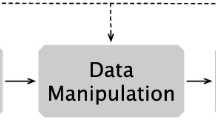Abstract
When tens and even hundreds of schemas are involved in the integration process, criteria are needed for choosing clusters of schemas to be integrated, so as to deal with the integration problem through an efficient iterative process. Schemas in clusters should be chosen according to cohesion and coupling criteria that are based on similarities and dissimilarities among schemas. In this paper, we propose an algorithm for a novel variant of the correlation clustering approach that addresses the problem of assisting a designer in integrating a large number of conceptual schemas. The novel variant introduces upper and lower bounds to the number of schemas in each cluster, in order to avoid too complex and too simple integration contexts respectively. We give a heuristic for solving the problem, being an NP hard combinatorial problem. An experimental activity demonstrates an appreciable increment in the effectiveness of the schema integration process when clusters are computed by means of the proposed algorithm w.r.t. the ones manually defined by an expert.
Similar content being viewed by others
References
Batini C, Lenzerini M, Navathe S B. A comparative analysis of methodologies for database schema integration. ACM Comput. Surv., 1986, 18(4): 323-364.
Spaccapietra S, Parent C, Dupont Y. Model independent assertions for integration of heterogeneous schemas. The VLDB J., 1992, 1(1): 81-126.
Spaccapietra S, Parent C. View integration: A step forward in solving structural conflicts. IEEE Trans. Knowl. Data Eng., 1994, 6(2): 258-274.
Yang X, Procopiuc C, Srivastava D. Summarizing relational databases. Proc. VLDB Endowment, 2009, 2(1): 634-645.
Wang X, Zhou X, Wang S. Summarizing large-scale database schema using community detection. J. Comput. Sci. Technol., 2012, 27(3): 515-526.
Yasir A, Kumara Swamy M, Krishna Reddy P. Exploiting schema and documentation for summarizing relational databases. In Proc. the 1st Int. Conf. Big Data Analytics, Dec. 2012, pp.77-90.
Algergawy A, Schallehn E, Saake G. A schema matchingbased approach to XML schema clustering. In Proc. the 10th Int. Conf. Information Integration and Web-Based Applications Services, Nov. 2008, pp.131-136.
Lee M L, Yang L H, Hsu W, Yang X. XClust: Clustering XML schemas for effective integration. In Proc. the 11th CIKM, Nov. 2002, pp.292-299.
Batini C, Ceri S, Navathe S B. Conceptual Database Design: An Entity-Relationship Approach (1st edition). Benjamin/Cummings Publishing Co., 1992.
Jain A K, Murty M N, Flynn P J. Data clustering: A review. ACM Comput. Surv., 1999, 31(3): 264-323.
Moody D L, Flitman A R. A decomposition method for entity relationship models: A systems theoretic approach. In Proc. the 1st Int. Conf. Systems Thinking in Management, Nov. 2000, pp.462-469.
Batini C, Di Battista G, Santucci G. Structuring primitives for a dictionary of entity relationship data schemas. IEEE Trans. Software Engineering, 1993, 19(4): 344-365.
Smith K, Mork P, Seligman L et al. The role of schema matching in large enterprises. In Proc. the 4th Biennial Conf. Innovative Data Systems Research, Jan. 2009.
Nayak R, Iryadi W. XML schema clustering with semantic and hierarchical similarity measures. Knowledge-Based Systems, 2007, 20(4): 336-349.
Banek M, Vrdoljak B, Min Tjoa A, Skocir Z. Automated integration of heterogeneous data warehouse schemas. Int. J. Data Warehousing and Mining, 2008, 4(4): 1-21.
Guerra F, Olaru M O, Vincini M. Mapping and integration of dimensional attributes using clustering techniques. In Proc. the 13th Int. Conf. E-Commerce and Web Technologies, Sept. 2012, pp.38-49.
Mahmoud H A, Aboulnaga A. Schema clustering and retrieval for multi-domain pay-as-you-go data integration systems. In Proc. Int. Conf. Management of Data, Jun. 2010, pp.411-422.
Otham R, Deris S, Illias R, Zakaria Z, Mohamed S. Automatic clustering of gene ontology by genetic algorithm. Int. J. Information Technology, 2006, 3(1): 37-46.
Hu W, Qu Y, Cheng G. Matching large ontologies: A divide-and-conquer approach. Data & Knowledge Engineering, 2008, 67(1): 140-160.
Zhao Y, Karypis G, Fayyad U. Hierarchical clustering algorithms for document datasets. Data Mining and Knowledge Discovery, 2005, 10(2): 141-168.
Bansal N, Blum A, Chawla S. Correlation clustering. Machine Learning, 2004, 56(1/2/3): 89-113.
Bonizzoni P, Della Vedova G, Dondi R, Jiang T. On the approximation of correlation clustering and consensus clustering. J. Comput. Syst. Sci., 2008, 74(5): 671-696.
Charikar M, Guruswami V, Wirth A. Clustering with qualitative information. J. Comput. Syst. Sci., 2005, 71(3): 360-383.
Demaine E, Emanuel D, Fiat A, Immorlica N. Correlation clustering in general weighted graphs. Theoretical Computer Science, 2006, 361(2): 172-187.
Papadimitriou C, Steiglitz K. Combinatorial Optimization: Algorithms and Complexity. Dover Publications, 1998.
Ausiello G, Crescenzi P, Gambosi G, Kann V, Marchetti-Spaccamela A, Protasi M. Complexity and Approximation: Combinatorial Optimization Problems and Their Approximability Properties (1st edition). Springer-Verlag, 1999.
Batini C, Comerio M, Viscusi G. Managing quality of large set of conceptual schemas in public administration: Methods and experiences. In Proc. the 2nd Int. Conf. Model and Data Engineering, Oct. 2012, pp.31-42.
Author information
Authors and Affiliations
Corresponding author
Additional information
The work was partially supported by the Italian Project PON01 00861 SMART (Services and Meta-services for smART eGovernment) and by the Project (CUP E41l13000220009) SPAC3 (Smart services of the new Public Administration for the Citizen-Centricity in the Cloud) co-financed by the Lombardy region.
Rights and permissions
About this article
Cite this article
Batini, C., Bonizzoni, P., Comerio, M. et al. A Clustering Algorithm for Planning the Integration Process of a Large Number of Conceptual Schemas. J. Comput. Sci. Technol. 30, 214–224 (2015). https://doi.org/10.1007/s11390-015-1514-5
Received:
Revised:
Published:
Issue Date:
DOI: https://doi.org/10.1007/s11390-015-1514-5




